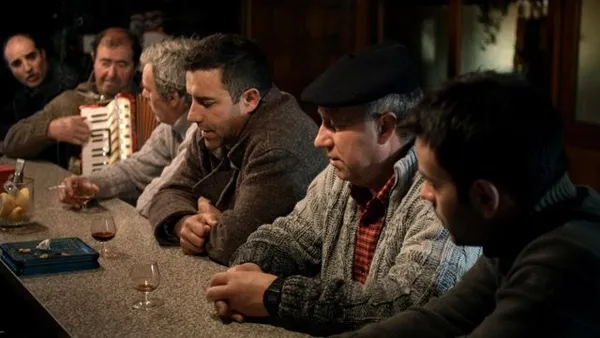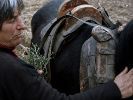Eye For Film >> Movies >> Arraianos (2012) Film Review
Arraianos
Reviewed by: Rebecca Naughten

One of a significant number of documentary fictions to originate from Galicia in recent years, Arraianos offers a portrait of the borderlands between Galicia and Portugal during the course of a year. The film's title refers to the inhabitants of the town of A Raia but the film itself occupies a broader and more nebulous territory - an otherworldly space outside of a specific time - utilising the natural world and the locals' relationship with it to construct a poetic and philosophical reverie.
This involves using the play O Bosque [O Forest] by Jenaro Marinhas del Valle as a structure around which the film can grow. In isolated sequences woven in among footage that follows a more ethnographic style of documentary-making, the play's dialogue is performed relatively flatly by non-professional actors - but their performances nonetheless highlight the musicality of the language (Galician) as they engage with the play's philosophical ponderings about the nature of things. Musicality is a through-line in the film, both in the language spoken and as isolated notes seemingly blown in on the breeze through the trees, or the communal singing of sea shanties by men in a bar, and women on a hillside taking turns to sing and laugh about lost loves.

The layered soundscape is an illustration of how carefully attuned Eloy Enciso's film is to its environment, and it often enables us to hear things before (or sometimes rather than) seeing them - for example, the sheep audibly but invisibly running through the higgledy-piggledy village in the dark. Sound also creates a bridge between images, as in the sequence where the song being sung by the men has recurring lines about rain - as the song ends and each man returns to silent introspection, one tilts his head as if listening, and the rain outside first becomes audible and then increases in volume (in both senses) as it bridges the cut to the subsequent image, of fields and trees half hidden in the mist of a torrential downpour.
Precipitation is likewise a connection between images and across the seasonal changes, and at times makes the landscape look as though it's underwater - seen in a murky gloom, the damp tangle of a densely-wooded forest covered in lichen resembles a shipwreck coated in seaweed. The colours and textures of the forest, and the way in which they are thrown into relief by the play of light, frequently make an abstract image of nature. One fleeting sequence in which the light rapidly moves - in accordance with time shifting (speeded up, seemingly) - between closely-packed and sharply upright trees, with the fluctuating contrast between vertical lines and gnarled bark turning the forms into abstract patterns, plays like James Benning's Nightfall in miniature.
The pin-sharp camerawork highlights surface textures in nature (moss, bark, leaves, water, earth, stone), on animals (horse hair, cow hide), and humans (lines on faces and hands, but also fabrics such as corduroy or woollens) - the film is a mosaic of tactile imagery. The land and its inhabitants are exposed to the elements and together must endure the inclement weather - there are furrows both in the earth and on weary faces. This landscape is one that is 'worked' - it can sustain its people, but that requires effort on their part - and to a certain degree it must be forcibly changed (eg the burning back of undergrowth or cutting down of trees) in order to be maintained.
Arraianos is not a conventional documentary in the sense of documenting the lives of a rural populace in an observational and ethnographic practice - although that is nonetheless one of the central aspects of the film, it simultaneously strives for a dreamlike atmosphere in conjunction with the existentialist fragments of O Bosque. Parallel to this dreamy otherworldliness, the sense of timelessness in the borderlands is conveyed not only by the modern world's lack of encroachment into this landscape (a wind farm on a hill is the most we see of the contemporary) but also through the use of black and white photographs of previous generations, who closely resemble those working the land today - the quality of its crystalline images aside (and it is a beautiful film), Arraianos could have been shot at any point in the past half a century and still have contained many of the same working customs, songs and faces. History therefore coexists alongside the present in this paean to a way of life tucked within the seams of the Galician borders and landscape.
Reviewed on: 16 May 2015
















